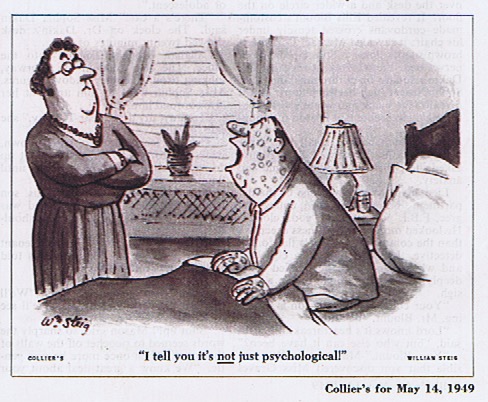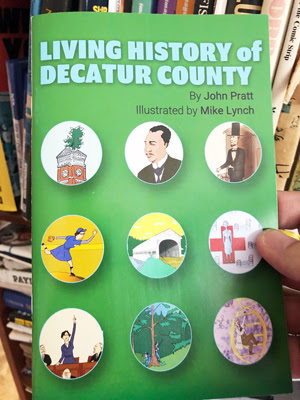Well, that good ol' Dick Buchanan got to thinking and he started pulling some golden age gag cartoon samples from his tremendous stock of magazines. What follows now and in the coming days is a trove of clichéd cartoons that the internet has never seen before. I am thankful and amazed at these samples Dick has put together for your pleasure. Most of these single panel cartoons have been unseen since their publication, for about a half a century.
Take it away, Dick!
----
GAG CARTOON CLICHÉS
1944 - 1970
Gag cartoon clichés were a staple of every magazine.
In the era of the great magazines several appeared in each and every issue. Some
were figments of imaginations of the cartooning mind while others were firmly
rooted in the everyday lives of the readers.
Many lists have been made to innumerate the cartoon
cliché. Each list differs and no list is complete. Gag cartoon clichés are
virtually infinite and ever changing.
Some have disappeared, falling victim to the evolving enlightenment of
civilization while others have vanished with the advancement of technology.
Never one to pass up a time wasting endeavor, I
have dipped in my Cartoon Clip File and emerged with a sampling of cartoon
clichés from the mid-century.
DESERT ISLAND
1. IRWIN CAPLAN. Liberty September 9,1944.
2. TON SMITS. Look Magazine November
7,1961.
3. VIRGIL PARTCH. Look Magazine
December 9, 1959.
CAVEMEN
2. GARDNER REA. True Magazine March,1948.
3. JAN VAN WESSUM. Evergreen Review
August 1970.
FORTUNE TELLERS
1. MISCHA RICHTER. For Laughing Out
Loud July-September,1963.
2. ROY WILLIAMS. Collier’s September
18,1948
3. MIKE WILLIAMS. Punch August 28,1968.
THE PSYCHIATRIST’S COUCH
1. JOHN GALLAGHER. American Legion
Magazine. January,1960.
2. ROBERT KRAUS. American Magazine August,1951
3. ORLANDO BUSINO. For Laughing Out
Loud October-December, 1957.
HUSBANDS READING AT THE BREAKFAST TABLE
1. SYD HOFF. Collier’s January 21,1955.
2. DICK ERICSON. Liberty May 25,1946.
More from Dick Buchanan's collection of gag cartoons:
From the Dick Buchanan Files: William Steig Gag Cartoons 1946 - 1965
From the Dick Buchanan Files: Favorite Gag Cartoons 1947 - 1958
From the Dick Buchanan Files: Hank Ketcham Gag Cartoons 1944 – 1952
From the Dick Buchanan Files: Hank Ketcham Roughs
From the Dick Buchanan Files: Holiday and Winter Cartoons 1948 - 1960
Dick Buchanan's Cartoon Files: More Cops and Robbers Gag Cartoons 1947 - 1968
Dick Buchanan's Favorite Gag Cartoons 1946 - 1964
From the Dick Buchanan Files: More 1960s Cartoons from PUNCH
From the Dick Buchanan Files: Virgil Parch Part One; VIP in the 1940s
From the Dick Buchanan Files: Virgil Parch Part Two; VIP in the 1950s
From the Dick Buchanan Files: Even More Color Cartoons 1940 - 1956
From the Dick Buchanan Files: "Captions? Who Needs 'Em?" Wordless Gag Cartoons 1947 – 1970
From the Dick Buchanan Files: Orlando Busino Gag Cartoons 1956 - 1966
From the Dick Buchanan Files: CARTOONYFELLERS’ DIGEST, "a 1955 rag for cartoonists by cartoonists"
From the Dick Buchanan Files: Magazine Cartoons from Life and Judge 1931 - 38
From the Dick Buchanan Files: June 1953 Cartoonist's Market Newsletter
Dick Buchanan's Cartoon File: More Mid-Century Gag Cartoons 1946 - 1964
Dick Buchanan's Cartoon File: Color Gag Cartoons 1946 - 1956
Dick Buchanan's Cartoon Files: Cops and Robbers Gag Cartoons 1945 - 1968
Dick Buchanan's Cartoon Files: Gahan Wilson: Early Gag Cartoons 1954 - 1964
Dick Buchanan's Cartoon File: Inkyfellers' Gagzette
Dick Buchanan's Cartoon File: The Years of Al Ross - 1947 – 1968
Dick Buchanan's Cartoon Files: New Yorker Cartoonists Abroad 1966-1968
Dick Buchanan's Cartoon File: 1945 - 1962
From the Dick Buchanan Files: "How I Create Humor" from 1950s - 60s Gag Cartoon Insider Journal "The Information Guide"
Dick Buchanan's Cartoon File: 1950s Color Magazine Gag Cartoons
Dick Buchanan's Cartoon File: Funny Vintage Magazine Gag Cartoons 1946 - 1963
Dick Buchanan's Cartoon File: Wordless Gag Cartoons 1944-1964
1953 George Booth Drawings for American Legion Magazine
Dick Buchanan: Winter/Christmas/Holiday Gag Cartoons 1940s-60s
Dick Buchanan: Some PUNCH Magazine Cartoons 1948-1963
Dick Buchanan: Gag Cartoon Clip File 1946-64
Dick Buchanan: Gag Cartoon Clip File 1947-62
Dick Buchanan: Some Favorite Magazine Gag Cartoons 1940-60s
Dick Buchanan: Gag Cartoon Clip File 1931-64
































































